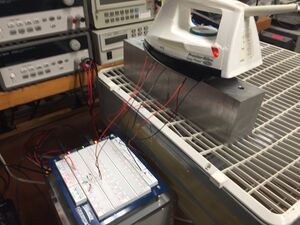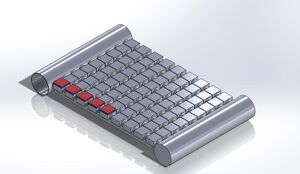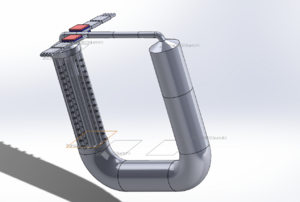Thermal Management for a High Efficiency Power Converter
| [[File:|300px|center|alt=]] | |
| H.E.E.T LOGO | |
| Sponsors | |
| Team Name | High Efficiency Electro Thermal |
| Duration | Fall 2015 - Spring 2016 |
| Faculty Advisers | |
| Mentor |
|
| Students |
|
Our goal is to design and model a thermal management system for a high efficiency power converter. Our system will direct heat away from electrical components and keep the system withing operating temperatures. Additionally the thermal management system with harvest the waste heat to create useful electricity to power the control system.
Problem Definition[edit | edit source]
Background[edit | edit source]
TEG Testing[edit | edit source]
To analyze the effectiveness of individual ThermoElectric Generators as well as various combinations we developed an experiment to acquire data. The TEGs were attached, with thermal paste, to a large block of aluminum. This served as the cold side. The hot side of the TEGs were then exposed to an iron at various temperatures and we recorded data
- NEED TO INPUT TABLE OF TEST RESULTS and a paragraph on analysis*
Deliverables[edit | edit source]
This project will deliver a working prototype with all relevant calculations and CAD models for future use and development.
Specifications[edit | edit source]
- MAKE THIS A TABLE*
Maintain 150 degrees Celsius on electronic components Generate Electricity required to power controllers Dissipate heat from system to atmosphere
Design[edit | edit source]
Our primary design features an array composed of Thermoelectric Generators (TEGs) to transfer heat away from the electric components on the hot side to the radiator fluid on the cold side. The radiator will then reject the remaining waste heat to the atmosphere.
TEG Array
The TEGs will be in *MAYBE, EDIT THIS* direct contact with the tabs of the electronic switches allowing for conduction of heat. The cold side of the TEG will be seperated from the radiator fluid by a very thin *INSULATED* (maybe) sheet to protect the electronics from the working fluid in the radiator while also maintaining some degree of insulation within the TEG itself to maximize the electricity recovered.
Radiator
The radiator itself will use *WORKING FLUID* to transport heat from the cold side of the TEGs to a fin array cooled by convection from a fan exposed to atmospheric air.
ELECTRICAL ENGINEERS Our design features STUFF? to manage the electricity supplied to the CONTROLLERS (write stuff please)
Project Learning[edit | edit source]
Team Information[edit | edit source]
| Jackson Bates | FILLER:
| |
| Electrical Engineering Undergraduate | ||
| Hometown: Longview, Washington | ||
| Email: bate5241@vandals.uidaho.edu | ||
| Greg Cotten | Filler:
| |
| Mechanical Engineering Undergraduate | ||
| Hometown: San Diego, California | ||
| Email: cott1826@vandals.uidaho.edu | ||
| Harrison Pugesek | Filler:
| |
| Mechanical Engineering Undergraduate | ||
| Hometown: Sandpoint, Idaho | ||
| Email: puge2778@vandals.uidaho.edu | ||
| Samantha Woodman | Filler:
| |
| Electrical Engineering Undergraduate | ||
| Hometown: Kailua, Hawai'i | ||
| Email: wood3767@vandals.uidaho.edu |




